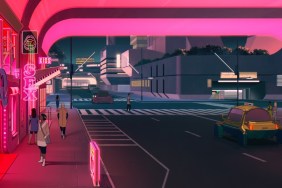You often hear people talking about “Sundance movies,” describing a certain type of indie aesthetic that’s evident in so many movies that premiere at Park City’s annual film festival. Alex Rivera’s debut Sleep Dealer is one that combines a number of elements that aren’t always attributed to the festival: its propensity for movies about the immigrant experience and its ability to find groundbreaking new voices and visions in science fiction.
In the latter category, we’ve seen the likes of Shane Carruth’s Primer come out of the festival, as well as this year’s class, Duncan Jones’ Moon and Sophie Barthes’ Cold Souls. Last year, Sleep Dealer was the science fiction movie everyone was talking about as Rivera’s debut feature won the coveted Alfred P. Sloan award as well as a screenwriting prize.
Set in a near future after Mexico has been walled off from the United States, it follows Memo Cruz (Luis Fernando Peña), a young man from the farming community of Santa Ana del Rio, who travels to the bustling city of Tijuana to work in the factories as a “sleep dealer,” a worker connected directly to the system via nodes implanted in their body, allowing them to control robots that perform intensive labor. This is a future where the war against immigration has reached its fevered pitch, as the United States sends jet fighters controlled by “sleep dealers” into Mexico to deal with anything considered a threat. Unfortunately, Memo has made their list after a harmless radio transmission is intercepted. In Tijuana, Memo meets Luz (Leonor Varela), who uses her own nodes to upload her memories onto the computer where anyone can purchase them as their own.
The relatively low budget film is astounding in the way it combines the natural environments of Mexico with 3D CGI to create a future that wouldn’t feel out of place in a Philip K. Dick or William Gibson novel, yet still maintains the level of characterization one would expect from a film that explores the very human aspects of trying to earn a living against the very real hardships of living in a Third World country.
ComingSoon.net didn’t get a chance to talk with Alex Rivera at Sundance last year, but we wanted to make time to learn more about his intriguing take on science fiction as Sleep Dealer finally gets a theatrical release.
ComingSoon.net: Since this was at Sundance last year, I guess you must have made it almost two years ago. Had it been in development a long time before that? What was the timeline for making the movie from when you first started it?
Alex Rivera: The answer to that question is an embarrassing one. I’m embarrassed to talk about the timeline because the truth is that I’ve been working on this film, thinking about it and dreaming about it, for about 12 years now.
CS: Oh, I’ve talked to filmmakers who’ve been making films for longer periods than that.
Rivera: Well, then I’m happy not to win that trophy, but I’d been thinking about this film for about 12 years. I had the original idea in 1997 and then was at Sundance in 2001 and met my producer there. We thought we’d be done in a year, and instead, it took until 2005 to get it financed, and then we shot it in 2006, edited in 2007, premiered in 2008 and make it to theaters finally and happily in 2009.
CS: Was this a very hard idea to sell to get financing? It seems like a couple years ago immigration was a huge hot topic, so did that make it easier to get financed eventually?
Rivera: You know, when we got this film financed back in 2005, immigration was not really a hot topic, but I think what got us funding was my producer’s perseverance, and the fact that this film, whether it’s a perfect film or not, it’s historic in that we’ve never seen a science fiction set in the future set outside of the First World. We’ve never seen the future of Mexico, we’ve never seen the future of Brazil or India, the whole rest of the planet, we’ve never seen that part of our world, which is where the majority of humanity lives, we’ve never seen it in the future. But we all know it has a future. I think to everybody involved, this is a chance to do something really new with the genre, and that’s what drew people and the investor to the project, the ideas.
CS: I haven’t seen your earlier films but I read a little about them, and it would seem that this is a logical extension to what you were doing in them, following similar ideas, but was there something in those movies you didn’t get a chance to explore? In some ways, it seems “Sleep Dealer” could even be set in the same world as those.
Rivera: Yeah, sure, that’s true. For the past fifteen years since I graduated college, I’ve been making short films and videos that look at immigrants’ lives and immigrants’ stories but I try to always do it through a cracked lens. I try to bring something fresh to what is an old story. In my first film, I looked at my dad’s life as an immigrant, but I focused on his relationship to the television and how he uses Spanish language television, even though he’s in America, to virtually return home. The TV for my immigrant dad is like a magical portal that lets him go home for a few hours every night. In a documentary I made, I looked at how Mexican immigrants in New York use money-wiring services, home videos, fax machines – they use technology to stay in touch with their villages in Mexico and to send money back to rebuild the village via remote control. In all these films that I’ve been making where there are immigrant lives as part of the story, there’s always been an element of technology and how technology connects North and South. How technology connects people who are divided by borders, and that’s the backdrop of “Sleep Dealer.”

CS: I was reading that your family is Peruvian, so did you know people who came here and were working as immigrants? Do you have a background in that in terms of relatives or acquaintances?
Rivera: My dad was an immigrant worker. He came to the United States to work and he worked in factories when he was young. My cousins keep coming and working in construction and gardening out on Long Island, so through my family, I’ve seen the experience of immigration and I’ve seen the impact of this war on immigrants that the U.S. is kind of involved with right now. Sometimes, that seemed like the stuff of science fiction.
CS: There’s always been this talk of building a wall between the U.S. and Mexico, but do you think it could ever get that extreme? At least at this point, it would seem like we’re getting past that way of thinking. Do you think things have changed so that’s not a potential future?
Rivera: I don’t know what the future is going to be, but I think science fiction is an incredible space in our culture to think about it. That’s what science fiction is best at, having dreams and nightmares about the future. In terms of the United States and Mexico, right now is a time when we’re living a bit of a nightmare in that there’s this very powerful movement in this country to try to cut the two countries in half, to build a wall and somehow stop the effect of Mexico to getting to America. What that movement is trying to stop is 500 years of history that the U.S. and Mexico were once one place. There are millions and millions of families, which are going back and forth; the economies are integrated. The idea of erecting a ten-foot wall and that that would somehow stop the flow of people between North and South is a fantasy, but a very powerful fantasy right now.
CS: The movie explores that a bit but deals with other things. This is a very ambitious film in terms of the FX and the environments. When you’re writing, how do you go about being able to realize what you’re coming up with since you probably won’t have a $20 to 30 million budget?
Rivera: The #1 key to making the science fiction film with no money was being completely naïve. Like I had no idea what I was getting into, but luckily, I had a really incredible and dedicated team of people who wanted to do something new in film. We got a lot of people to work harder than they should have and to work for free that made this whole thing possible. I’d say also that this film is set partly in Oaxaca and partly in Tijuana, Mexico and when you try to imagine the future of Oaxaca or Tijuana, it’s different than being Steven Spielberg trying to imagine the future of Los Angeles. I’m not imagining a future of skyscrapers and flying cars where everyone is wearing different clothes. To me, the future of Mexico is a very interesting collage where some things have gotten older and more funky, the streets look mostly the same, and there’s like capillary veins, little details of technology that pulse through the world and that pop up. I’m not forecasting or I’m not predicting a future that’s totally different, so that also saves us money on the budget.
CS: I can imagine. Did you end up shooting completely in Mexico?
Rivera: We shot completely in Mexico.
CS: What was involved with integrating the real environments with the CG stuff? I assume you couldn’t do a lot of green screen stuff.
Rivera: We did some green screen. We did some practical visual FX like blowing up buildings, and we did some composite FX where we were putting screens into existing locations. We did some scenes that were entirely 3D generated. We did a bit of everything, but actually, the rule of thumb, the way that I wanted to create the visual world was the exteriors, I tried to scout and find real-life science fiction locations. For example, there’s a beach where the United States and Mexico meet and on that border beach, there’s a giant wall that runs along the sandy beach and out into the ocean. That’s production design done by Homeland Security, it’s a bizarre environment that is there, but it looks to me like science fiction and it costs nothing to film. I just scouted that location and we put it in the film. The shantytowns on the outskirts of Tijuana, to me like crazier than anything I’ve seen in “Mad Max” so we filmed there. A lot of the exteriors were as they are and they’re science fiction reality. Then on the interiors, we were able to populate with more design and little bits of technology that made the film overall feel futuristic.
CS: As far as the casting, I know that Leonor and Jacob have done quite a bit of work in Hollywood and are fairly well established. For Memo, did you want to make sure to get a fairly unknown Mexican actor? What was the plan of casting those three roles since they have to carry the movie?
Rivera: My plan was to get actors who had worked before and had been through it before, and who I could lean on if necessary. I wanted actors who bring strong visions for the characters because I’d never been though it before. Really in every department, I had to surround myself with experience. Luis Fernando Peña who plays the lead of our movie, he hasn’t really broken out into the U.S. market but he’s been in over five feature films in Mexico, he works a lot on Mexican TV, and to me, he’s like a young Javier Bardem. I think he brings a really profound depth to the screen.

CS: I’m going to ask you the same question I’ve asked other filmmakers who had movies at Sundance ’08. Has the movie changed at all since it premiered at least year’s festival? Having that time since finishing it, has that made you want to go back and revisit or work on things afterward? Did you work on it more or is it exactly the same?
Rivera: I’m an obsessive compulsive freak (chuckles) so there are so many things in the movie that I would change if I could. It’s probably for the best that we didn’t open the film up because I might never have stopped working on it. (laughs) We’re releasing the Sundance version.
CS: Since it’s been a year since you finished the movie, what would you like people to get out of the movie?
Rivera: I think the film is like a prism. You can look at it from many different angles and see different things in it, and I’m happy for that. If some people want to come and see a really lush, colorful, bizarre vision of the future and go for a ride, I think that’s there. If they’re open to it, there’s also intellectual or political arguments about the world and where we’re going as a society. That’s why I made the film is to try to use science fiction to hold up a cracked mirror to our society and say, “If this looks absurd or violent or terrible or so dark it’s funny… well, that’s the world that we just might be building in our reality.” We might live in this movie’s world if we don’t change course. That was the impulse behind the film, but I’m also happy if people should want to come because the actors are beautiful.
CS: The movie got a couple of prestigious awards at the festival, so do you have a lot more opportunities coming in from people in Hollywood, saying “Hey, if he can make this movie look so good with no money, maybe he can do something with a little more money and make it more amazing”?
Rivera: I’ve definitely been taken on a surreal ride through Hollywood, which has landed me in a room working with Salma Hayek on a film based on a true story about Latinos and robots, so there’s been some interesting things that have come out of this journey so far.
CS: Do you know if she saw your movie at Sundance or afterwards?
Rivera: I think afterward.
CS: Do you see yourself exploring more ethnic-specific genre in the future? I think Guillermo del Toro and Alfonso Cuaron are two of the few who have tried to explore that stuff, at least that we’ve seen here.
Rivera: Absolutely. I hope that this film is like the first seed of a tree that can grow into a new genre and that genre can be called like “Third World Cyberpunk” or “Cross-Border Cyberpunk” or “Sci-Fi Globalization.” I’m not sure what to call it but I think there’s a space in our cinema for a new genre, and I’m hoping that this film is a provocation and maybe the start of that.
Sleep Dealer opens in 40 theaters in New York and L.A. on Friday.









